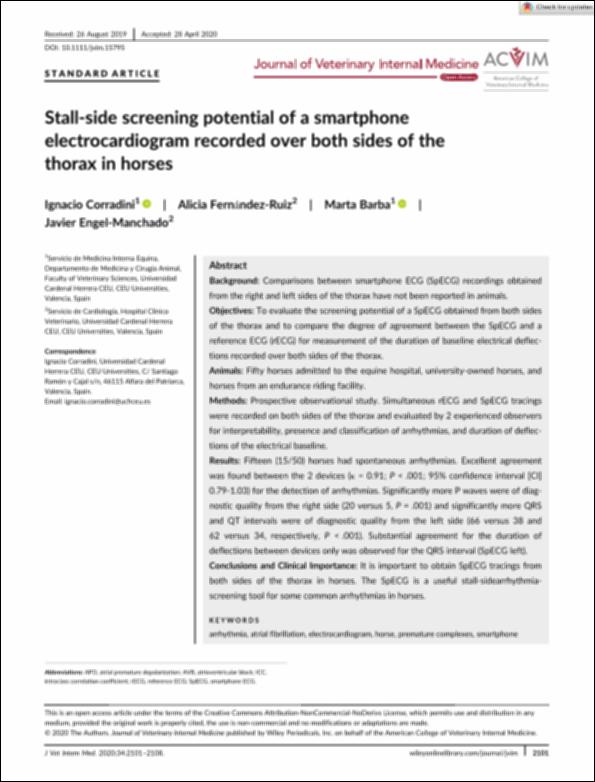Please use this identifier to cite or link to this item:
http://hdl.handle.net/10637/12578Stall-side screening potential of a smartphone electrocardiogram recorded over both sides of the thorax in horses
| Title: | Stall-side screening potential of a smartphone electrocardiogram recorded over both sides of the thorax in horses |
| Authors : | Corradini, Ignacio Fernández Ruiz, Alicia Barba Recreo, Marta Engel Manchado, Javier |
| Keywords: | Caballos - Aparato circulatorio.; Horses - Cardiovascular system.; Teléfono móvil - Aplicaciones en Veterinaria.; Cellular telephones in Veterinary medicine.; Atrial fibrillation.; Electrocardiografía en veterinaria.; Fibrilación atrial.; Veterinary electrocardiography. |
| Publisher: | John Wiley & Sons. |
| Citation: | Corradini, J., Fernández-Ruiz, A., Barba, M. & Engel-Manchado, J. (2020). Stall-side screening potential of a smartphone electrocardiogram recorded over both sides of the thorax in horses. Journal of Veterinary Internal Medicine, vol. 34, i. 5 (01 sep.), pp. 2101-2108. DOI: https://doi.org/10.1111/jvim.15795 |
| Abstract: | Background: Comparisons between smartphone ECG (SpECG) recordings obtained from the right and left sides of the thorax have not been reported in animals. Objectives: To evaluate the screening potential of a SpECG obtained from both sides of the thorax and to compare the degree of agreement between the SpECG and a reference ECG (rECG) for measurement of the duration of baseline electrical deflections recorded over both sides of the thorax. Animals: Fifty horses admitted to the equine hospital, university-owned horses, and horses from an endurance riding facility. Methods: Prospective observational study. Simultaneous rECG and SpECG tracings were recorded on both sides of the thorax and evaluated by 2 experienced observers for interpretability, presence and classification of arrhythmias, and duration of deflections of the electrical baseline. Results: Fifteen (15/50) horses had spontaneous arrhythmias. Excellent agreement was found between the 2 devices (κ = 0.91; P < .001; 95% confidence interval [CI] 0.79-1.03) for the detection of arrhythmias. Significantly more P waves were of diagnostic quality from the right side (20 versus 5, P = .001) and significantly more QRS and QT intervals were of diagnostic quality from the left side (66 versus 38 and 62 versus 34, respectively, P < .001). Substantial agreement for the duration of deflections between devices only was observed for the QRS interval (SpECG left). Conclusions and Clinical Importance: It is important to obtain SpECG tracings from both sides of the thorax in horses. The SpECG is a useful stall-sidearrhythmiascreening tool for some common arrhythmias in horses. |
| Description: | En Journal of Veterinary Internal Medicine. Hoboken (New Jersey, Estados Unidos): John Wiley & Sons. Vol. 34, n. 5, pp. 2101-2108 (01 sep. 2020). ISSN 0891-6640. e-ISSN 1939-1676. Este es el artículo que se ha publicado de forma definitiva en: https://onlinelibrary.wiley.com/doi/epdf/10.1111/jvim.15795 Este trabajo fue presentado en el 11th ECEIM Anual Congress, November, Genk, Bélgica. |
| URI: | http://hdl.handle.net/10637/12578 |
| Rights : | http://creativecommons.org/licenses/by-nc-nd/4.0/deed.es |
| ISSN: | 0891-6640. 1939-1676 (Electrónico). |
| Issue Date: | 1-Sep-2020 |
| Center : | Universidad Cardenal Herrera-CEU |
| Appears in Collections: | Dpto. Medicina y Cirugía Animal |
Items in DSpace are protected by copyright, with all rights reserved, unless otherwise indicated.


